German WW1 Military Burials in Belgium
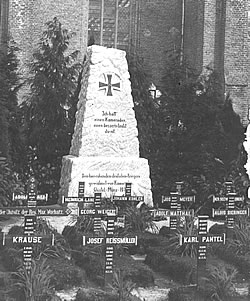
|
At the end of the First World War there were 128 German military burial sites spread across Belgium throughout 678 districts. The sites ranged in size from a single grave to sites with 3,212 burials. Added to this there were thousands of individual or group burial plots in fields, woods, ditches, canal banks and alongside roads. German soldiers had also been buried in civilian cemeteries or in British and French military cemeteries.
The total number of German soldiers who died in the main battle zone of Flanders has never been confirmed. According to the German war graves agency, the Volksbund Deutsche Kriegsgräberfürsorge (VDK) , the total casualty figure of German casualties who died in Flanders is believed to be approximately 210,000.
The remains of 127,000 identified or unidentified German soldiers are interred within four Flanders' cemeteries (Hooglede, Langemarck, Menen, Vladslo) and in various British military cemeteries in Belgium. Of this total at least 120,000 are considered to have been killed within the province of Flanders. Included in this number is a figure of about 16,500 soldiers who were inexperienced Kriegsfreiwillige (War Volunteers), most of them aged 17 to 19, killed within the first few months of the war in the autumn battles of 1914.
This leaves a figure of approximately 83,000 German soldiers whose remains have never been discovered, whose remains cannot be accounted for and who are, therefore, “missing”.
Many individual graves and some cemetery sites were destroyed during the battles of 1917 and 1918. Some soldiers simply disappeared into the fields of Flanders without a trace.
Care for German Graves

|
In 1925 the German and Belgian governments reached an agreement whereby the “Amtliche Deutscher Gräberdienst in Belgien” - the “Official German Burial Service in Belgium” - was set up by the German Foreign Office. In close co-operation with the Belgian authorities, the French Service des Pensions and the Commonwealth War Graves Commission the exhumation and reburial of German military dead was started for those who were not already in a formal burial site. In most cases the exhumations were carried out for individual graves or small plots, so they could be transferred for reburial and cared for in a designated German military cemetery. Due to the scale of the thousands of German graves to be exhumed in Flanders, the work was co-ordinated by the Official German Burial Service from two offices, one in Ghent and one in Ypres.
Up until 1939 the privately funded Volksbund Deutsche Kriegsgräberfürsorge (VDK) was able to work in conjunction with the Official German Burial Service in Belgium. In so doing it was able to fulfil one of its aims, which was to be able to arrange for wreaths and photographs of graves to be taken for relatives. The VDK established connections with German regimental associations and veterans associations. It managed to secure private funding for the maintenance of the German military cemeteries through sponsorship.
Two cemeteries in Belgium were redeveloped solely due to sponsorship from the VDK. These were Langemarck-Nord, also known as the “Studentenfriedhof” (The Students' Cemetery) with 10,143 war dead and Roeselaere-de Ruyter with 2,806 war dead.
Care for German Graves During the Second World War
With the outbreak of the Second World War the Official German Burial Service in Belgium was disbanded. For the duration of the war the Belgian Goverment, Belgian Red Cross and the organization '‘Nos Tombes - Onze Graven'’ undertook to look after the German military cemeteries.
New Challenges after 1945
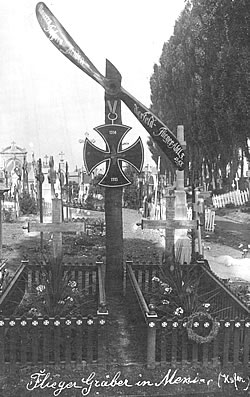
|
In 1954 an agreement was reached between Belgium and the Federal Republic of Germany. This was to enable an official German organisation to maintain German graves in Belgium again. However, the German government did not set up a new offical governmental organization, rather it handed the task on to the private organization the Volksbund Deutsche Kriegsgräber Fürsorge (VDK).
With regard to the German soldiers of the Second World War killed in Belgium, Allied burial parties moved all of them into two collecting cemeteries: Lommel (39,000) and Recogne-Bastogne (7,000). There are no Second World War German military dead buried in Flanders.
The Creation of Three “Collecting” Cemeteries
In 1954 it was also agreed by the VDK and the German Foreign Office that all the First World War German dead from the many smaller cemeteries in Flanders should be moved into three 'collecting' cemeteries. This decision was based on the experience of the inter-war years, where so many graves and cemeteries were requiring attention in locations which were outside Germany's borders.
The cemeteries selected as Collecting Cemeteries were already in existence and were:
- Langemarck-Nord: graves from 18 cemeteries were brought in and after the the reinterment the burials totalled over 44,234.
- Vladslo: graves from 61 locations were brought in to Vladslo and after the reinterment the burials totalled 25,638.
- Menen: graves from 49 cemeteries were brought in to Menen and after the reinterment the burials totalled 47,864. This became the largest German military cemetery in Belgium.
A decision was taken to move all the unidentified German dead during this major reinterment to Langemark cemetery, because room was available to create a mass grave, or “Kameraden Grab” (Comrades Grave) as it is also called.
During 1957-58 these three First World War collecting cemeteries were renovated according to designs by the VDK’s chief architect Robert Tischler. He died before the cemeteries were completed.
German Burials Retained Outside the Collecting Cemeteries
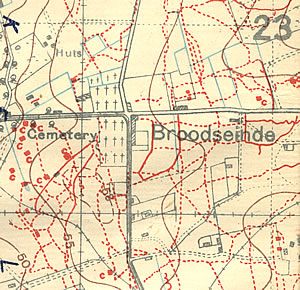
|
When the task of the exhumation and reburial into the collecting cemeteries began, it was also decided to leave the German graves in two existing cemeteries in Belgium. These were:
- Zeebrugge: a small military cemetery with 173 German graves.
- Hooglede: the 8,247 WW1 burials were not moved from this cemetery.
It was also agreed not to exhume the 1,105 German soldiers who had been buried in 79 British military cemeteries in Flanders. The highest number of Germans buried in a British cemetery in Belgium is 213 in Lijssenthoek Military Cemetery south of Poperinge.
Traces of Original German Cemeteries
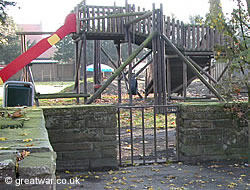
|
In most cases all traces of the actual location of the many original burial sites have been removed.
However, in the Ypres Salient there is an interesting example of a site in which elements of the cemetery's construction have been retained. It was called Poelcapelle Dorf (Poelcapelle Village) and later, Cemetery 124. There were 532 identified burials and over 200 unknown burials. It was one of 8 German cemeteries in the area of Poelkapelle.
The cemetery location is situated on the east side of the N313 Brugesweg, just to the south of the five ways roundabout junction in Poelkapelle (with the stork memorial to the French air ace Georges Guynemer).
The former German cemetery is now the location of a small park with a childrens' playground.
Related Topics
Langemark German Military Cemetery
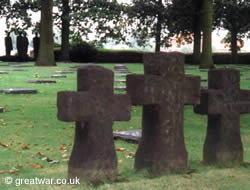
|
For information about the cemetery go to:
Langemark German Military Cemetery, BelgiumVolksbund Deutsche Kriegsgräber Fürsorge (VDK)
The Volksbund Deutsche Kriegsgräber Fürsorge (VDK) is responsible for the maintenance and care of German war graves around the world. For more information about the VDK go to:
Volksbund Deutsche Kriegsgräber FürsorgeAcknowlegements
Source: Volksbund Deutsche Kriegsgräber Fürsorge
(1) - (3) Photographs courtesy of the late Bridgeen Fox (Private Collection)